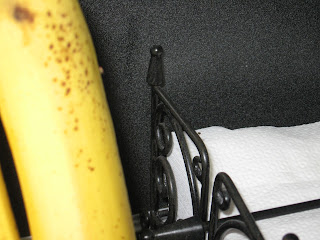 |
| fruit fly: photo courtesy of Andre' Karwath; wikipedia.org |
How do you keep from being overrun with those itty bitty fruit flies lingering around your fruit bowl? As with any bugs, cleanliness can go a long way to keep unwanted guest out of your house. So, to prevent fruit flies in the first place, here's a few tips to help out:
- Use or discard all overripe fruit. Leaving fruit left to rot is sending an invitation to fruit flies to breed in your home.
- If possible, clean your fruits and veggies at a makeshift cleaning station outside of your home.
- Cover your fruit bowl or store your fruits in the refrigerator.
- Clean off opened bottles of fruit juice and fermented or vinegar products.
- Don't throw away food scraps in garbage cans inside your home.
- Wash all dishes after use.
- Wash dishrags regularly.
- Wipe up spills and crumbs from counter tops, cabinets, and floors as quickly as possible.
- Take your trash out daily.
- Keep those easy to forget areas around your dishwasher, stove, and refrigerator clean.
- Dump out mop water; clean the pail and mop.
Fruit flies breed and live in warm, moist environments like garbage disposals and drains. Keep these areas clean by using a hard bristle brush. You can also pour a little household bleach down the drain to kill any fruit flies breeding there.
What if you already have fruit flies. Here's some do-it-yourself suggestions that I came across.
- First, remove the source! If you leave the rotting peach on the counter, these tricks are not going to work!
I found several methods of trapping them. The lure is different, but the general idea is the same. Put your bait (we'll talk about different kinds in a moment) in a jar. Make a paper funnel and place it in the jar/bottle. The flies will go in, but they can't figure out how to get back out! After last Friday's post, I decided I would go home and try some of these tricks. I got home to find that my children had accidentally started an experiment for me! Someone had finished off the orange juice and left the "empty" container sitting on the counter all day. Inside, floating in the small sips of leftover OJ, were two house flies. The picture didn't turn out very well, but here are our two friends:
So, it looks like flies like the orange juice bait. Other suggested baits include:
- a piece of rotten fruit in a jar
- wine
- apple cider vinegar
- also, adding a small amount of dish washing detergent to a liquid bait helps to trap the flies
Since there wasn't much orange juice in our container, I decided to add a little white cooking wine and a squirt of dish detergent. After topping it off with a funnel, the experiment continued to see how the fruit flies would respond. We let it sit and watched it all weekend. There were many times I'd walk by and see fruit flies crawling on the funnel, but I wasn't sure if they were finding their way in or not.
I decided to make another trap using apple cider vinegar. By the end of the weekend there were only 2-3 fruit flies in that one. For us, it wasn't very successful. I did read that heating the cider vinegar releases more of the vinegar fragrance. Maybe I'll try that next time.
However, I must say that the orange juice/white cooking wine combo worked quite well. By the end of the weekend, this is what we had trapped:
We'd love to hear your experiences. If you've tried any of these tricks or maybe even some not mentioned, let us know how they worked for you!

















